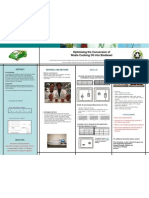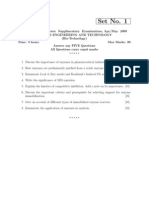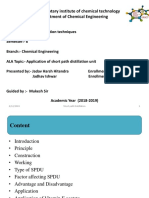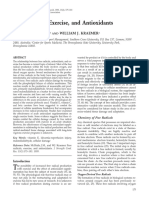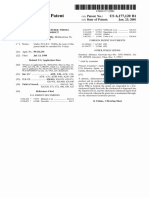Ast Spdu 1
Ast Spdu 1
Uploaded by
Chemical Engg.Copyright:
Available Formats
Ast Spdu 1
Ast Spdu 1
Uploaded by
Chemical Engg.Original Description:
Original Title
Copyright
Available Formats
Share this document
Did you find this document useful?
Is this content inappropriate?
Copyright:
Available Formats
Ast Spdu 1
Ast Spdu 1
Uploaded by
Chemical Engg.Copyright:
Available Formats
Shroff S.
R Rotary institute of chemical technology
Department of Chemical Engineering
Subject:- Advance separation techniques
Semester:- 6
Branch:- Chemical Engineering
ALA Topic:- Application of short path distillation unit
Presented by:- Jadav Harsh Hitendra Enrollment no:- 160990105013
Jadhav Ishwar Enrollment no:- 160990105014
Guided by :- Mukesh Sir
Academic Year (2018-2019)
4/12/2019 Short path Distillation 1
Content
• Introduction
• Principle
• Construction
• Working
• Type of SPDU
• Factor affecting SPDU
• Advantage and Disadvantage
• Application
• Application of Vitamin E acetate
4/12/2019 Short path Distillation 2
Introduction
• Short path distillation is a technique by which heat
sensitive chemicals can be distilled efficiently.
• Short path distillation is usually performed under
vacuum at a pressure less than 0.001 mbar
• It is a process in which distillation apparatus consist of
condenser and evaporator fitted in a single unit.
• The distance between evaporator and condenser surface
is only of few centimeters.
• Hence it provides lowest distillation temperature and
short residence time.
• Thus reduces possibility of thermal degradation of
product
4/12/2019 Short path Distillation 3
Principle
The principle of short path distillation can be understood from the figure below:
4/12/2019 Short path Distillation 4
4/12/2019 Short path Distillation 5
Construction
1. Residue Discharge
2. Heater jacket
3. Roller wiper
4. Space under vacuum
5. Internal condenser
6. Feed
7. Geared motor
8. Heating medium inlet
9. Heating medium outlet
10. Exhaust
11. Cooling medium inlet
12. Cooling medium outlet
13. Distillate discharge
4/12/2019 Short path Distillation 6
Working
• Feed is continuously fed at top through a rotating distributor plate.
• Distributor is rotated using motor.
• Distributor plate distributes feed uniformly on the heat transfer surface.
• Feed flows down on heat transfer surface by gravity and gets heated.
• Heat required can be provided by thermic fluid, steam or hot water.
• This heat causes partial vaporization of feed.
• Vapor travel through the distillation gap to condenser surface where heat is
removed by cooling coils.
• Cooling medium can be cooling water, chilled water, oil or brine.
4/12/2019 Short path Distillation 7
Types of short path distillation units.
• There are mainly two types of short path distillation units based on force used for
distribution of liquid feed:
1. Falling film short path distillation unit; which uses gravitational force to
allow the liquid to be distributed as a thin film on a vertical vaporizer surface .
2. Centrifugal short path distillation unit; which uses centrifugal force
generated by rotor to promote the formation of thin film.
• The separation principle of both type of distillation unit is same
• There is also a third kind of short path distillation unit based on working;
– Reactive short path distillation unit; which is a combination of reactor and a
short path distillation unit
– Reactive short path distillation can be of both; falling film or centrifugal unit
type.
4/12/2019 Short path Distillation 8
Factors affecting short path distillation
• The parameters affecting the molecular diffusion are feed and condensation
temperature, feed rate, pressure and concentration of feed.
• With increase in temperature and decrease in pressure, the separation increases.
• By increasing the temperature, product purity increases but its yield decreases.
4/12/2019 Short path Distillation 9
Short path Distillation Vacuum distillation
• High purity. • Less purity.
• Temperature variation is • Vast temperature variation.
less. • Denature take place .
• Denature doesn't take
place.
4/12/2019 Short path Distillation 10
Advantages and Disadvantages
• Advantages
– Can be used for thermally sensitive substances.
– Components with high boiling points can be distilled easily due to high
vacuum.
– There is minimum pressure drop in the system due to short distance between
vaporizer and condenser unit.
– It requires relatively less maintenance.
– High purity of end products is obtained.
• Disadvantages
─ high vacuum is required for carrying out distillation.
─ High operating cost.
4/12/2019 Short path Distillation 11
It is called molecular distillation when
• If distance travelled by vapor molecules from the vaporization
surface to surface of internal condenser is less than mean free path
of molecule between two successive collision then SPDU is called
molecular distillation.
4/12/2019 Short path Distillation 12
Application
• Separation of fat soluble vitamins.
• Grape seed oil decaffeination
• Separation of fatty acids from vegetable oil.
• Increasing citral concentration in lemongrass oil.
• Removing phthalates from sweet orange oil.
• Separation of waxes, fats and natural oils.
• For fish oils, petroleum residues, solvent removals.
• In fractionation of milk fat.
• For enrichment of carotene.
• For recovery of polyphenols, tocopherols and sterols from deodorizer distillate.
4/12/2019 Short path Distillation 13
For separation of vitamin E
• Use for synthesis of vitamin E as well as natural vitamin E.
• In 100kg crude vitamin E acetate it contain 78.75kg pure vitamin E
acetate. 13.73 kg residue and 7.5kg low boiling impurities.
• Pure vitamin E obtain as light yellow pure oil.
• Deodorizer distillate of edible oil is source of natural vitamin E.
• It concentration varies from 3-10% by mass in distillate of soybean
oil depending upon operating condition of deodorizer.
• Concentration upto 40% by mass can be carried out in SPDU.
4/12/2019 Short path Distillation 14
Distillation of vitamin E acetate
4/12/2019 Short path Distillation 15
Short path distillation for recovery of Polyphenols from
deodorizer distillate
• Polyphenols are identified as the natural compounds which impart antioxidant
property and thus improve shelf life.
• During physical refining of rapeseed oil, polyphenols gets separated and
concentrates in the distillate along with fatty acids, tocopherols, sterols, etc.
• Thus oil obtained as bottom product is lean in polyphenols and hence lags in
antioxidant property.
• So in order to obtain natural antioxidant, deodorizer distillate is treated in short path
distillation to separate them from free fatty acids which act as oxidants.
4/12/2019 Short path Distillation 16
Short path distillation for recovery of Polyphenols from
deodorizer distillate
• The effect of various parameters was studied experimentally which is stated as
follows:
– At 110°C about 43% of the material was evaporated to the distillate phase
whereas at 170°C the total distillate yield was approximately 86%.
– A separation factor near one is equivalent to an inefficient separation.
– Separation efficiency between FFA and tocopherols increases with decrease in
evaporation temperature with decrease in distillate rate.
– Whereas when experiment were carried out for different feed rates (100-300
mL/h) at 110°C no significant change was observed
4/12/2019 Short path Distillation 17
Continue..
Oil and Fat Industry
• Separation of free fatty acids from vegetable oil Fractionation of
tall oil
Petrochemical Industry
• Fractionation of synthetic and petrochemical waxes to soft-and
hard waxes
4/12/2019 Short path Distillation 18
Continue..
Chemical Industry
• Separation of long chain acid chlorides from impurities and free
acids
• Solvent separation from silicon oils
• Concentration and purification of esters
• Purification of organic esters
Food Industry
• Separation of solvents from flavors
• Concentration of juices or extracts
4/12/2019 Short path Distillation 19
Continue..
Pesticides produce
• Purification and refining of pesticides and its intermediate
Polymer Industry
• Purification and concentration of monomers Purification and
concentration of polymers Purification of softeners
Painting industry
• Subtractive solvent of polyurethane partial polymer and separation
of TDI monomer
4/12/2019 Short path Distillation 20
Continue..
Cosmetic industry
• Producing wool alcohols and wool acid of sheep oil Wiping off
pesticides of cosmetic substrate
• Pharmaceutical and Food Industry
• Concentration of sugar / Glucose solutions and fruit pulps.
4/12/2019 Short path Distillation 21
Thank you
4/12/2019 Short path Distillation 22
You might also like
- Topic:-Factors influencing the λmax value: BS Hons. Chemistry (6 Semester)No ratings yetTopic:-Factors influencing the λmax value: BS Hons. Chemistry (6 Semester)21 pages
- UNIT-1: Question Bank Fem-401: Leather & Footwear Testing 2015-16No ratings yetUNIT-1: Question Bank Fem-401: Leather & Footwear Testing 2015-164 pages
- Model Exam Paper - CET-II (3140507) Summer 2020 Midsem Sem.No ratings yetModel Exam Paper - CET-II (3140507) Summer 2020 Midsem Sem.2 pages
- Dimethylformamide (DMF) : The Applications and AlternativesNo ratings yetDimethylformamide (DMF) : The Applications and Alternatives2 pages
- Sem 5 Bt6502 Bioprocess Engg Question BankNo ratings yetSem 5 Bt6502 Bioprocess Engg Question Bank39 pages
- Unit 4 Preprations and Standardisation of Standard SolutionsNo ratings yetUnit 4 Preprations and Standardisation of Standard Solutions41 pages
- Principle of HPLC Operation Comparison Between GC and HPLC Typical Industrial ApplicationNo ratings yetPrinciple of HPLC Operation Comparison Between GC and HPLC Typical Industrial Application49 pages
- DR CVS Subrahmanyam Faculty Profile 2019 PDF33% (6)DR CVS Subrahmanyam Faculty Profile 2019 PDF3 pages
- In Vitro Dissolution Testing Models: Seminar OnNo ratings yetIn Vitro Dissolution Testing Models: Seminar On23 pages
- Introduction To Pharmaceutical Organic Chemistry CharacteristicsNo ratings yetIntroduction To Pharmaceutical Organic Chemistry Characteristics34 pages
- Punjab College Pattoki: Spring 2021: Course Outline Bs Program Semester 6ThNo ratings yetPunjab College Pattoki: Spring 2021: Course Outline Bs Program Semester 6Th8 pages
- An Importance and Advancement of QSAR Parameters in Modern Drug Design: A ReviewNo ratings yetAn Importance and Advancement of QSAR Parameters in Modern Drug Design: A Review9 pages
- Poster For Optimisation of The Conversion of Waste Cooking Oil Into BiodieselNo ratings yetPoster For Optimisation of The Conversion of Waste Cooking Oil Into Biodiesel1 page
- Determination of The PH Value of Water Using A PH Meter100% (1)Determination of The PH Value of Water Using A PH Meter7 pages
- Chemistry Project On Analysis of Cold DrinksNo ratings yetChemistry Project On Analysis of Cold Drinks9 pages
- Bpharm 2 Sem Pharmaceutical Organic Chemistry 1 BP 202t 2019 PDFNo ratings yetBpharm 2 Sem Pharmaceutical Organic Chemistry 1 BP 202t 2019 PDF1 page
- rr222303 Enzyme Engineering and TechnologyNo ratings yetrr222303 Enzyme Engineering and Technology4 pages
- Determination of Saponification Value of Castor OilNo ratings yetDetermination of Saponification Value of Castor Oil2 pages
- S.A. Raja Pharmacy College: Vi - Semester - (Iii-B.Pharm)No ratings yetS.A. Raja Pharmacy College: Vi - Semester - (Iii-B.Pharm)51 pages
- Course Code:: PHR-322: Pharmaceutical Analysis-LlNo ratings yetCourse Code:: PHR-322: Pharmaceutical Analysis-Ll7 pages
- 331490085 Group 6 Molecular Distillation (2)No ratings yet331490085 Group 6 Molecular Distillation (2)14 pages
- Gujarat Technological University: Bachelor of EngineerNo ratings yetGujarat Technological University: Bachelor of Engineer12 pages
- The Complete Book of Vitamins and Minerals For Health - Vaughn, Lewis Faelten, Sharon - 1988 - EmmNo ratings yetThe Complete Book of Vitamins and Minerals For Health - Vaughn, Lewis Faelten, Sharon - 1988 - Emm760 pages
- Impact of Pork Consumption On Human Health: July 2020No ratings yetImpact of Pork Consumption On Human Health: July 202010 pages
- Chapter 7: M.G.Rajanandh, Dept. of Pharmacy Practice, SRM College of Pharmacy, SRM University100% (1)Chapter 7: M.G.Rajanandh, Dept. of Pharmacy Practice, SRM College of Pharmacy, SRM University134 pages
- Free Radicals, Exercise, and AntioxidantsNo ratings yetFree Radicals, Exercise, and Antioxidants9 pages
- Food Chemistry FD-203 (3+1) : Fall Semester 2021 Second Year Food Engineering Batch 2020No ratings yetFood Chemistry FD-203 (3+1) : Fall Semester 2021 Second Year Food Engineering Batch 202050 pages
- Production and Processing of A Functional Yogurt Fortified With MNo ratings yetProduction and Processing of A Functional Yogurt Fortified With M90 pages
- Animal Health Product Manufacturer, Herbal / Organic Veterinary ProductsNo ratings yetAnimal Health Product Manufacturer, Herbal / Organic Veterinary Products25 pages
- The Effect of Vitamin Premixes On Some Physiological and Biochemical Indicators of The Body of Laying HensNo ratings yetThe Effect of Vitamin Premixes On Some Physiological and Biochemical Indicators of The Body of Laying Hens4 pages
- Role of Free Radicals in Health and DiseaseNo ratings yetRole of Free Radicals in Health and Disease49 pages
- United States Patent (10) Patent No.: US 6, 177,120 B1: Jackeschky (45) Date of Patent: Jan. 23, 2001No ratings yetUnited States Patent (10) Patent No.: US 6, 177,120 B1: Jackeschky (45) Date of Patent: Jan. 23, 20017 pages
- 6BBL0325 2 TheoriesofAgeingRandomDamageNo ratings yet6BBL0325 2 TheoriesofAgeingRandomDamage10 pages
- Egg Basics For The Consumer: Packaging, Storage, and Nutritional InformationNo ratings yetEgg Basics For The Consumer: Packaging, Storage, and Nutritional Information6 pages
- Topic:-Factors influencing the λmax value: BS Hons. Chemistry (6 Semester)Topic:-Factors influencing the λmax value: BS Hons. Chemistry (6 Semester)
- UNIT-1: Question Bank Fem-401: Leather & Footwear Testing 2015-16UNIT-1: Question Bank Fem-401: Leather & Footwear Testing 2015-16
- Model Exam Paper - CET-II (3140507) Summer 2020 Midsem Sem.Model Exam Paper - CET-II (3140507) Summer 2020 Midsem Sem.
- Dimethylformamide (DMF) : The Applications and AlternativesDimethylformamide (DMF) : The Applications and Alternatives
- Unit 4 Preprations and Standardisation of Standard SolutionsUnit 4 Preprations and Standardisation of Standard Solutions
- Principle of HPLC Operation Comparison Between GC and HPLC Typical Industrial ApplicationPrinciple of HPLC Operation Comparison Between GC and HPLC Typical Industrial Application
- Introduction To Pharmaceutical Organic Chemistry CharacteristicsIntroduction To Pharmaceutical Organic Chemistry Characteristics
- Punjab College Pattoki: Spring 2021: Course Outline Bs Program Semester 6ThPunjab College Pattoki: Spring 2021: Course Outline Bs Program Semester 6Th
- An Importance and Advancement of QSAR Parameters in Modern Drug Design: A ReviewAn Importance and Advancement of QSAR Parameters in Modern Drug Design: A Review
- Poster For Optimisation of The Conversion of Waste Cooking Oil Into BiodieselPoster For Optimisation of The Conversion of Waste Cooking Oil Into Biodiesel
- Determination of The PH Value of Water Using A PH MeterDetermination of The PH Value of Water Using A PH Meter
- Bpharm 2 Sem Pharmaceutical Organic Chemistry 1 BP 202t 2019 PDFBpharm 2 Sem Pharmaceutical Organic Chemistry 1 BP 202t 2019 PDF
- Determination of Saponification Value of Castor OilDetermination of Saponification Value of Castor Oil
- S.A. Raja Pharmacy College: Vi - Semester - (Iii-B.Pharm)S.A. Raja Pharmacy College: Vi - Semester - (Iii-B.Pharm)
- Advanced Techniques of Analytical Chemistry: Volume 1From EverandAdvanced Techniques of Analytical Chemistry: Volume 1
- Gujarat Technological University: Bachelor of EngineerGujarat Technological University: Bachelor of Engineer
- The Complete Book of Vitamins and Minerals For Health - Vaughn, Lewis Faelten, Sharon - 1988 - EmmThe Complete Book of Vitamins and Minerals For Health - Vaughn, Lewis Faelten, Sharon - 1988 - Emm
- Impact of Pork Consumption On Human Health: July 2020Impact of Pork Consumption On Human Health: July 2020
- Chapter 7: M.G.Rajanandh, Dept. of Pharmacy Practice, SRM College of Pharmacy, SRM UniversityChapter 7: M.G.Rajanandh, Dept. of Pharmacy Practice, SRM College of Pharmacy, SRM University
- Food Chemistry FD-203 (3+1) : Fall Semester 2021 Second Year Food Engineering Batch 2020Food Chemistry FD-203 (3+1) : Fall Semester 2021 Second Year Food Engineering Batch 2020
- Production and Processing of A Functional Yogurt Fortified With MProduction and Processing of A Functional Yogurt Fortified With M
- Animal Health Product Manufacturer, Herbal / Organic Veterinary ProductsAnimal Health Product Manufacturer, Herbal / Organic Veterinary Products
- The Effect of Vitamin Premixes On Some Physiological and Biochemical Indicators of The Body of Laying HensThe Effect of Vitamin Premixes On Some Physiological and Biochemical Indicators of The Body of Laying Hens
- United States Patent (10) Patent No.: US 6, 177,120 B1: Jackeschky (45) Date of Patent: Jan. 23, 2001United States Patent (10) Patent No.: US 6, 177,120 B1: Jackeschky (45) Date of Patent: Jan. 23, 2001
- Egg Basics For The Consumer: Packaging, Storage, and Nutritional InformationEgg Basics For The Consumer: Packaging, Storage, and Nutritional Information








































